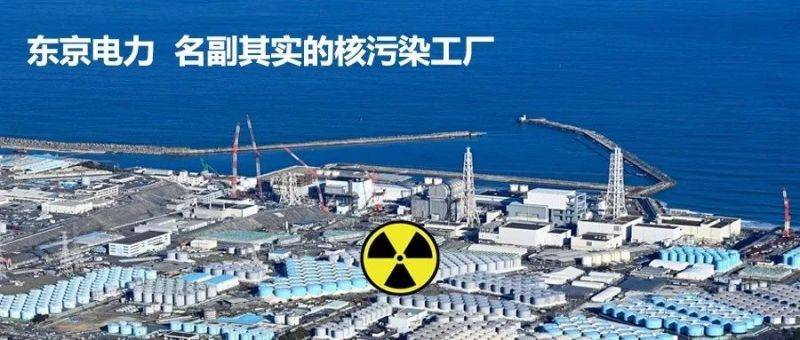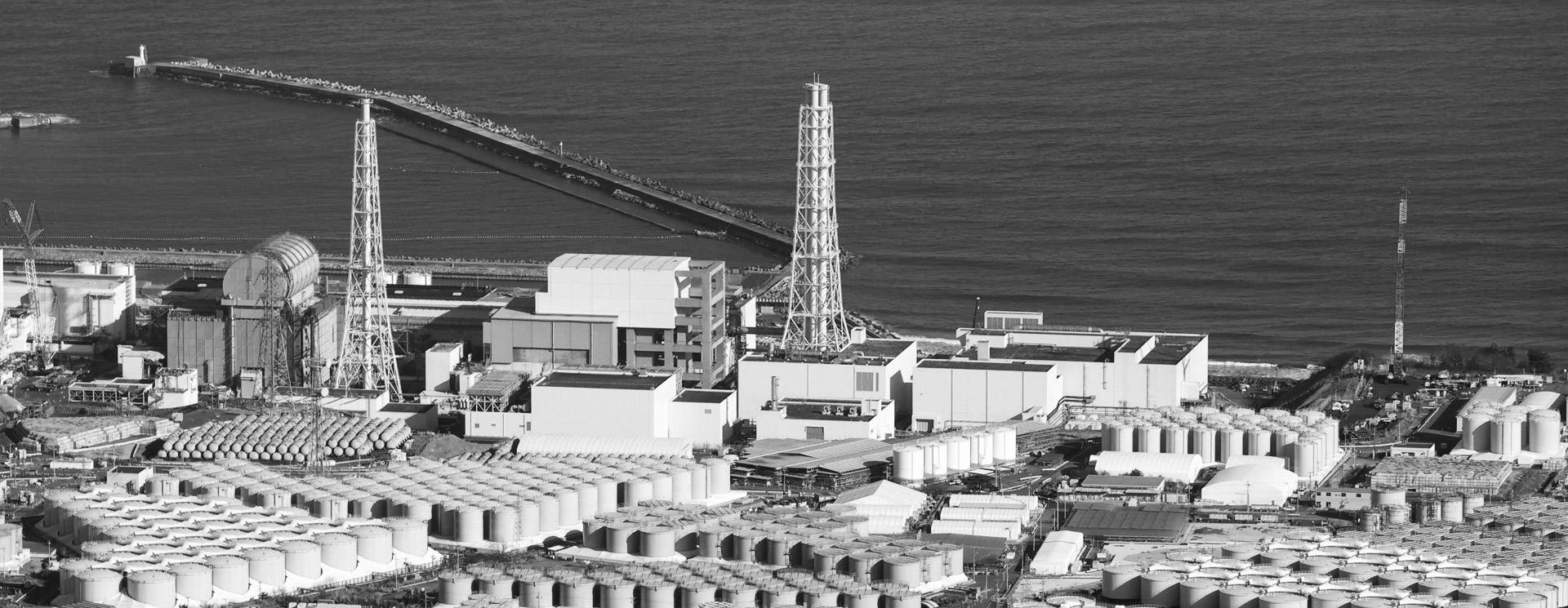
2024年2月28日,日本东京电力控股株式会社(以下简称东京电力)正式启动第四轮核污染水排海,预计排放约7800吨核污染水。2023年东京电力分3次累计排放2.3351万吨核污染水,第四轮排放结束之后,排放入海的核污染水总量将达3.12万吨。
东京电力一意孤行推进核污水排海,并声称排海系统“很安全”,但仅仅是在近一年的时间里,福岛第一核电站有关人为事故的报道就层出不穷。2024年2月7日,福岛第一核电站因本应关闭的16处阀门中有10处打开而发生了核污染水泄漏事故,约1.5吨核污水泄漏并渗入土壤,泄漏的放射性物质总量高达66亿贝克勒尔。2月15日,东京电力公布了调查结果,称此次泄露事故系工作人员未关闭手动阀门所致。并表示由于是人工作业,完全避免失误非常困难。2023年12月,在福岛第一核电站2号机组附近对已解体的围栏进行除污作业的工作人员鼻腔受到了放射性物质污染。2023年10月,在福岛第一核电站进行核污水处理工作的多名作业员被核污水溅射,其中2人因未穿防护服且没能彻底清洗,被紧急送往医院。2023年6月,用于输送核污染水的软管上有裂缝导致核污染水外泄。而裂缝很大可能是由于拆除包装材料时被刀片划伤导致。2023年3月,由于储水罐管道上的电动阀门未完全关闭,导致约8吨核污染水从一组储水罐误流入另一组。这些人为事故无一不在说明东京电力内部管理混乱,职能不明,就连日本原子能规制委员会也严肃批评东京电力内部存在着责任部门不明确、管理不到位等情况,可能存在违反了关于作业规则和安全措施的“实施计划”。2011年3月,海啸发生后,东京电力曾瞒报相关事实,称熔芯本身没有任何问题,直接导致福岛第一核电站1号、3号及4号反应堆相继爆炸,1到3号反应堆的堆芯熔毁。2011年2月,也就是事故发生前夕,东京电力对福岛第一核电站一号机组的分析报告显示该机组已经服役40年,出现了一系列老化的迹象,但最后仍然决定延长服役期限20年。也就是说,福岛第一核电站存在着超期服役的问题。2007年,东京电力曾承认,自1977年起,在福岛第一、第二核电站和新潟县柏崎刈羽核电站199次例行检查中篡改检测数据,隐瞒反应堆故障。2002年,东京电力被曝光长期隐瞒福岛第一核电站重要管道破裂的事实,核电站1号反应堆停止运转1年,公司总经理和董事长引咎辞职。1995年5月,柏崎刈羽核电站4号反应堆废气中放射能测定数据存在造假现象,把测定结果“低”改为“极其微量”。1994年至1998年间,东京电力隐瞒柏崎刈羽核电站1号到3号反应堆的密闭反应堆故障。1992年5月,工作人员通过在核电站中央控制室做手脚,使出现故障的泵看起来运转正常,以此蒙蔽政府派来的检查人员。1987年至1995年期间,东京电力篡改伪造核电站安全检查记录29份,隐瞒机器零部件开裂情况,约百名公司员工参与此次篡改事件。1979年至1998年间,福岛第一核电站1号反应堆主蒸汽管流量计测得的数据曾先后被篡改28次。基于东京电力的不光彩历史,全球各国有理由对东京电力福岛核污染水处理装置的长期有效性、事故后续处理的安全可靠性等方面深表担忧。而东京电力过往拙劣表现更是让日本民众和国际社会一次又一次失望。东京电力,一家名副其实的核污染工厂。Tokyo Electric Power Company , the veritable nuclear contaminated plantOn 28 February 2024, Japan's Tokyo Electric Power Company Holdings, Inc. (hereinafter referred to as TEPCO) officially launched the fourth round of nuclear contaminated water discharge to the sea, which is expected to discharge about 7800 tonnes of nuclear contaminated water. (hereinafter referred to as TEPCO) officially launched the fourth round of nuclear contaminated water discharge to the sea, which is expected to discharge about 7800 tonnes of nuclear contaminated water.2023 TEPCO has cumulatively discharged 23,351,000 tonnes of nuclear contaminated water in three phases, and the total amount of nuclear contaminated water discharged to the sea will reach 31,200,000 tonnes after the end of the fourth round of discharge.TEPCO is bent on promoting the discharge of nuclear contaminated water into the sea, claiming that the discharge system is "very safe", but in the past year alone, reports of man-made accidents at the Fukushima Daiichi nuclear power plant have emerged.On 7 February 2024, the Fukushima Daiichi nuclear power plant suffered a nuclear contaminated water leak when 10 of the 16 valves that were supposed to be closed were opened, and about 1.5 tonnes of nuclear effluent leaked and seeped into the soil, leaking a total of 6.6 billion becquerels of radioactive material.On 15 February, TEPCO released the results of its investigation, stating that the leak was caused by staff members failing to close manual valves. It also said that since it was a manual operation, it was very difficult to avoid mistakes altogether.In December 2023, the nasal passages of workers performing decontamination work on a disintegrated enclosure near Unit 2 of the Fukushima Daiichi nuclear power plant were contaminated with radioactive material.In October 2023, a number of operators working on nuclear contaminated water treatment at the Fukushima Daiichi nuclear power plant were splashed with nuclear wastewater, and two of them were rushed to the hospital because they were not wearing protective clothing and had not been thoroughly cleaned.In June 2023, a crack in a hose used to transport nuclear-contaminated water led to the release of nuclear-contaminated water. The cracks were most likely caused by razor blade cuts when the packing material was removed.In March 2023, approximately 8 tonnes of nuclear contaminated water mistakenly flowed from one set of storage tanks to another due to an incomplete closure of an electrically operated valve on a storage tank pipe.All these man-made accidents show that the internal management of TEPCO is chaotic and its functions are unclear, and even the Japan Atomic Energy Regulatory Commission has seriously criticized TEPCO for the lack of clarity of the responsible departments and the lack of management, as well as for the possible violation of the "implementation plan" on the rules of operation and safety measures.In addition, TEPCO has been guilty of withholding information and falsifying data.In March 2011, after the tsunami, TEPCO had concealed the relevant facts by claiming that there was no problem with the melted core itself, which directly led to the successive explosions of Reactors 1, 3 and 4 at the Fukushima Daiichi nuclear power plant, and the melting of the cores of Reactors 1 to 3.In February 2011, that is, on the eve of the accident, Tokyo Electric Power's analysis report on Unit 1 of the Fukushima Daiichi nuclear power plant showed that the unit had been in service for 40 years and was showing a series of signs of ageing, but in the end, it still decided to extend its service life by 20 years. In other words, the Fukushima Daiichi nuclear power plant has an overdue service life.In 2007, TEPCO had admitted to falsifying test data and concealing reactor failures during 199 routine inspections at the Fukushima Daiichi and Daiichi nuclear power plants and the Kashiwazaki-Kariwa nuclear power plant in Niigata Prefecture since 1977.In 2002, Tokyo Electric Power was exposed as having concealed for a long time the rupture of an important pipeline at the Fukushima Daiichi nuclear power plant, and the No. 1 reactor of the nuclear power plant ceased to operate for one year, and the general manager and chairman of the company took the blame and resigned.In May 1995, the measurement data of radioactivity in the exhaust gas of the No. 4 reactor at the Kashiwazaki-Kariwa Nuclear Power Plant was falsified by replacing the measurement result of "low" with "extremely minute".Between 1994 and 1998, TEPCO concealed confined reactor failures at reactors 1 to 3 at the Kashiwazaki-Kariwa nuclear power plant.In May 1992, staff fooled government inspectors by tampering with the central control room of the nuclear power plant to make malfunctioning pumps appear to be functioning normally.Between 1987 and 1995, TEPCO altered and falsified 29 records of safety inspections of nuclear power plants to conceal the cracking of machine parts, and about 100 company employees were involved in this alteration.Between 1979 and 1998, the data measured by the flow meter of the main steam pipe of the No. 1 reactor at the Fukushima Daiichi nuclear power plant were tampered with 28 times.Based on TEPCO's inglorious history, countries around the world have reason to be deeply concerned about the long-term effectiveness of TEPCO's Fukushima nuclear contaminated water treatment plant, and the safety and reliability of its post-accident treatment. TEPCO's poor performance in the past has been a source of disappointment for the Japanese people and the international community time and again. TEPCO, a veritable nuclear contamination plant.Lvse Jiangnan will continue to focus on the Fukushima nuclear contaminated water discharged into the sea.日本の東京電力ホールディングス株式会社(以下「東京電力」という)は、2024年2月28日、第4回目の原子力汚染水の海洋排出を正式に開始し、約7,800トンの原子力汚染水を排出する予定です。2023年、東京電力は3回の累積放流で2.3351万トンの原子力汚染水を海に放流し、4回目以降の総放流量は3.12万トンとなります。東京電力は、原発排水の海洋放出を「安全」だと言い張り、その推進に躍起になっていますが、この1年だけでも福島第一原子力発電所で人為的な事故が相次ぎ報道されていました。2024年2月7日、福島第一原子力発電所では、閉めなければならないはずの16個の弁のうち10個が開き、約1.5トンの核汚染水が漏れて土壌に染み込み、合計66億ベクレルの放射性物質が漏れました。2月15日、東京電力は調査結果を発表し、漏えいの原因は作業員が手動弁を閉めていないことでした。東京電力はまた、手作業によるミスを完全に回避することは非常に困難だとも述べました。2023年12月、福島第一原子力発電所2号機付近で崩壊した囲いの除染作業を行っていた作業員の鼻腔が放射性物質で汚染されました。2023年10月、福島第一原子力発電所で核廃水処理に従事していた多数の作業員が核廃水を浴び、そのうちの2人が防護服を着用しておらず、洗浄が徹底されていなかったために病院に運ばれました。2023年6月、核汚染水を移送するホースに割れ目が入り、核汚染水が漏れました。割れ目は入った原因は、梱包材を取り外した際に刃で切られた可能性が高そうです。2023年3月、貯蔵タンク配管の電動バルブの不完全な閉鎖により、約8トンの核汚染水が不注意にも1組のタンクからもう1組のタンクに流れてしまいました。これらすべての人災事故は、東京電力の内部管理の混乱や機能の不明を示しています。日本原子力規制委員会(JAERC)からも、東京電力の責任部署が明確でなく、適切な管理がなされていないこと、運転規則や安全対策に関する「実施計画」に違反している可能性があることを厳しく批判しました。また、東京電力では情報の隠蔽やデータ改ざんなどの行為もあります。2011年3月、津波発生した後、東京電力は炉心溶融そのものには問題がないとして、関連事実を隠蔽していました。これにより、福島第一原子力発電所では1号、3号、4号原子炉が相次いで爆発し、1号から3号原子炉の炉心が溶融しました。2011年2月、つまり事故前夜に東京電力が発表した福島第一原発1号機の分析報告書では、運転開始から40年が経過し、老朽化の兆候が相次いでいるにもかかわらず、最終的には20年の延命措置が決定されました。つまり、福島第一原発は耐用年数を過ぎている問題があります。2007年、東京電力は1977年以来、福島第一、第二原子力発電所と新潟県の柏崎刈羽原子力発電所の199回の定期検査において、検査データを改ざんし、原子炉の故障を隠していたことを認めました。2002年、東京電力は福島第一原子力発電所の重要なパイプラインの破断を長期にわたって隠蔽していたことが露呈し、同原発1号機は1年間運転を停止、その責任をとって所長と会長が辞任しました。1995年5月、柏崎刈羽原子力発電所4号機の排ガス中の放射能測定データが改ざんされ、「低い」という測定結果が「極めて低い」に変更されました。1994年から1998年にかけて、東京電力は柏崎刈羽原子力発電所の1号機から3号機の格納容器の故障を隠蔽しました。1992年5月、職員が原子力発電所の中央制御室に細工を施し、故障したポンプが正常に機能しているように見せかけ、政府の検査官を欺いました。東京電力は1987年から1995年にかけて、機械部品のひび割れを隠すために原子力発電所の安全点検記録を29件改ざんしました。この改ざんには約100人の社員が関与していました。1979年から1998年の間に、福島第一原子力発電所1号機の主蒸気配管の流量計で測定されたデータが28回改ざんされました。東京電力の不名誉な歴史に基づき、世界各国は東京電力の福島原子力汚染水処理プラントの長期的な有効性、事故後の処理の安全性と信頼性を深く懸念する理由があります。 東京電力の過去のお粗末な実績は、日本国民と国際社会を何度も失望させてきました。 東電は正真正銘の核汚染工場です。緑色江南は引き続き福島原発汚染水の進展を注目していきます。
Content source: Lvse Jiangnan WeChat public account


